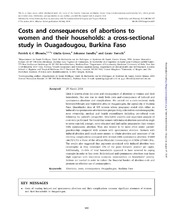Costs and consequences of abortions to women and their households: A cross-sectional study in Ouagadougou, Burkina Faso
Peer reviewed, Journal article
Published version
Permanent lenke
https://hdl.handle.net/1956/10281Utgivelsesdato
2015Metadata
Vis full innførselSamlinger
- Department of Economics [288]
Originalversjon
https://doi.org/10.1093/heapol/czu025Sammendrag
Little is known about the costs and consequences of abortions to women and their households. Our aim was to study both costs and consequences of induced and spontaneous abortions and complications. We carried out a cross-sectional study between February and September 2012 in Ouagadougou, the capital city of Burkina Faso. Quantitative data of 305 women whose pregnancy ended with either an induced or a spontaneous abortion were prospectively collected on sociodemographic, asset ownership, medical and health expenditures including pre-referral costs following the patient’s perspective. Descriptive analysis and regression analysis of costs were performed. We found that women with induced abortion were often single or never married, younger, more educated and had earlier pregnancies than women with spontaneous abortion. They also tended to be more often under parents’ guardianship compared with women with spontaneous abortion. Women with induced abortion paid much more money to obtain abortion and treatment of the resulting complications compared with women with spontaneous abortion: US89 (44 252 CFA ie franc of the African Financial Community) vs US56 (27 668 CFA). The results also suggested that payments associated with induced abortion were catastrophic as they consumed 15% of the gross domestic product per capita. Additionally, 11–16% of total households appeared to have resorted to coping strategies in order to face costs. Both induced and spontaneous abortions may incur high expenses with short-term economic repercussions on households’ poverty. Actions are needed in order to reduce the financial burden of abortion costs and promote an effective use of contraceptives.

